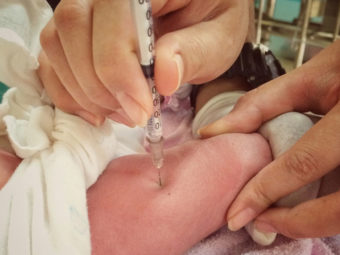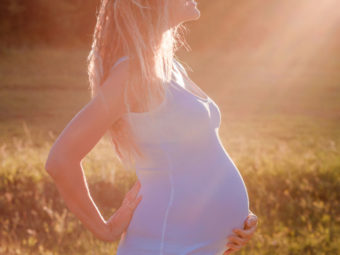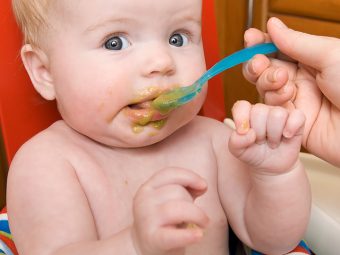
FPIES, or Food Protein-Induced Enterocolitis Syndrome, is a rare and potentially severe food allergy. It generally starts after four months and within the first year of life (1) (2). While the exact causes of FPIES in babies are not well understood, it may be due to an immune reaction to specific proteins in food and can lead to gastrointestinal symptomsiXSymptoms related to health problems affecting the gastrointestinal tract that runs from the mouth to the rectum (3) (4). This post discusses the causes, symptoms, and treatment options for FPIES in babies, including strategies to help parents and caregivers better understand and manage this condition.
How Common Is FPIES?
FPIES is not a common food allergy, occurring in about 0.51% of infants in the US (5). Thus, given its rarity, you should learn how to spot the signs and care for children with this condition.
What Are The Symptoms Of FPIES In Babies?
The symptoms of FPIES allergy typically present two to four hours after ingestion of the trigger food (6). These symptoms may differ in severity and from child to child (7) (6):
- Severe or projectile vomitingiXA forceful vomiting where the stomach contents eject at a distance from the body
- Dehydration
- Diarrhea
- Pale appearance
- Lack of energy
- Excessive drop in blood pressure (rare)
Children with chronic or multiple FPIES episodes may experience (4):
Be watchful
What Causes FPIES In Babies?
The exact mechanism behind FPIES is not well-understood. However, it is believed to be a non-IgEiXImmunoglobulin E is a type of antibody that causes an allergic reaction when a foreign particle enters the body -induced allergic reaction, making the body react to a specific protein in food. This improper immune reaction causes inflammation in the small and large intestines allowing fluid to pass through the intestinal wall into the gut lumen. This fluid shift can lead to symptoms such as vomiting and diarrhea (2) (3).
What Are The Risk Factors For FPIES In Babies?
FPIES may affect anyone, and some factors put babies at an increased risk (8) (3):
- The incidence of FPIES is more in males than in females.
- 40 to 80% of the FPIES cases appear in infants with a family history of atopic diseasesiXA genetic condition where the body reacts to environmental substances and produces an allergic reaction .
- FPIES may be more prolonged in infants if it develops with an IgE-mediated food allergy. Such cases are called “atypical FPIES.”
Which Foods Can Trigger FPIES in Babies?
Although any food may cause FPIES, the common triggers are cow’s milk, oats, soy, and rice. Since the child must directly consume the allergen for a reaction to occur, formula-fed infants are more likely to experience the symptoms than breastfed babies. However, breastfed babies may sometimes show mild sensitivity to certain foods in the maternal diet (7).
Other food triggers include (5):
- Barley
- Chicken, turkey, and egg white
- Sweet or white potato and green pea
- Fruits
- Fish and mollusks
How Is FPIES Diagnosed?
The standard IgE-targeted skin prick and blood tests are usually negative for FPIES. Thus, the doctor may thoroughly assess the child’s medical history, evaluate the symptoms, and exclude all the potential causes of other allergic reactions to learn the exact reason behind the condition (1) (7).
Additionally, a “supervised oral food challenge test” may be conducted with common trigger foods while monitoring the child’s response (7).
How Is FPIES Treated And Managed?
After diagnosis, based on the symptoms, their severity, and the causative agents, FPIES may be treated or managed in the following ways (7):
1. Changes in the eating habits
- Completely avoiding the foods causing triggers.
- Replacing ingredients in case of sensitivity to soy and dairy-based infant formulas.
- Switching to exclusive breastfeeding in case of solid-food sensitivity.
2. Medical treatment
- Steroids to reduce the intensity of immune reactions. They will bring down the response but will not treat the condition completely.
- Administration of intravenous fluids to replenish the water lost during vomiting and dehydration in case of severe condition.
The child may be monitored for improvement throughout the treatment, and the doctor may instruct to reintroduce the trigger foods or introduce new foods if they feel the child has outgrown the condition (9).
Point to consider
What Is The Outlook For A Child With FPIES?
FPIES is not permanent; about 60 to 90% of children outgrow it by three years (5). However, some may experience symptoms past their adolescent stage. Nevertheless, the prognosis for FPIES in babies looks good, with children achieving stable and healthy growth with proper nutrition and timely management (7).
Quick fact
When To See A Doctor For FPIES In Babies?
Besides being mindful of the other symptoms of FPIES, if the child experiences changes in their body temperature, you should take them to the hospital promptly to help prevent the risk of shock (7).
1. Is it possible to have FPIES to more than one food?
Yes. Babies with FPIES may react to one, two, or multiple foods (10).
2. How is FPIES different from many common food allergies?
The difference between FPIES and common food allergies are (10):
- A typical food allergy reaction occurs within minutes of ingesting the trigger food, whereas an FPIES reaction takes hours.
- A food allergic reaction is caused by IgE antibodies, whereas FPIES is a non-IgE-mediated response.
3. What are low-risk foods for FPIES?
The delayed onset of FPIES symptoms, such as vomiting, diarrhea, and dehydration, makes it challenging. It is essential for parents and caregivers to be aware of the signs and symptoms of FPIES in babies and to work closely with a healthcare provider to determine the best course of treatment. This may include an elimination diet and carefully monitoring the child’s response to reintroduced foods. With proper management, children affected with FPIES can have a healthy and stable life.
Key Pointers
- FPIES is a non-IgE-induced allergic reaction in infants within the first year of life that causes the body to react to a food protein.
- The typical food triggers are cow’s milk, soy, oats, and rice, but they may also include chicken, barley, potatoes, and fruits.
- The most effective treatment is completely removing the trigger foods until the baby is no longer sensitive to them.
- The child may outgrow the condition, but it is essential to be mindful of the symptoms to help prevent shock.











































